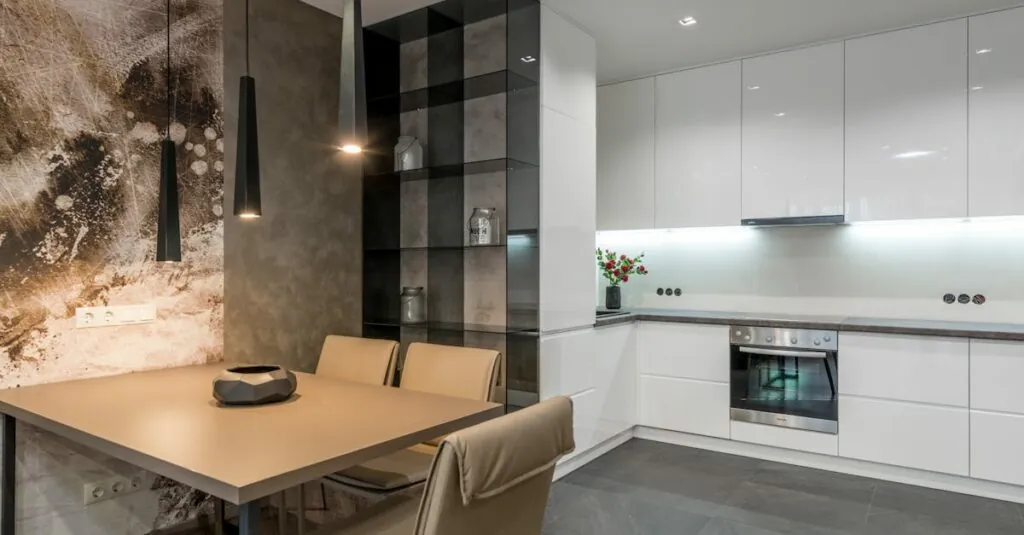Transforming a kitchen isn’t just about picking the right color for the walls or the latest trendy backsplash. It’s an art form where functionality meets flair, and every detail counts. Whether you’re a culinary wizard or someone who just wants to microwave leftovers in style, the right design can make all the difference.
Table of Contents
TogglePopular Kitchen Design Concepts
Kitchen design concepts reflect the blend of functionality and style. Several styles cater to diverse preferences and lifestyles.
Modern Kitchen Design
Modern kitchen design emphasizes clean lines and sleek finishes. Open layouts enable easy movement and interaction. Technology integration enhances convenience through smart appliances. Neutral color palettes paired with bold accents create striking visuals. Minimalist decor reduces clutter, allowing spaces to appear larger and more inviting.
Traditional Kitchen Design
Traditional kitchen design incorporates classic elements and rich materials. Wood cabinets often feature intricate carvings and details. Warm colors create a cozy atmosphere that invites gatherings. Decorative moldings and vintage-inspired fixtures add timeless charm. Functional layouts prioritize workflow, making meal preparation seamless and efficient.
Rustic Kitchen Design
Rustic kitchen design draws inspiration from nature and the countryside. Natural wood finishes and exposed beams evoke a warm, inviting environment. Earthy tones blend harmoniously with the surroundings. Open shelving displays dishes and heirloom kitchenware, adding personal touches. Functional, cozy spaces invite comfortable cooking and dining experiences.
Minimalist Kitchen Design
Minimalist kitchen design centers around simplicity and efficiency. Fewer decorative elements create a peaceful atmosphere. Streamlined cabinetry and hidden storage solutions reduce visual clutter. Monochromatic color schemes enhance a sense of spaciousness. Essential tools are easily accessible, ensuring a functional cooking environment without distractions.
Key Elements of Kitchen Design
Effective kitchen design relies on several key elements, each contributing to functionality and style.
Layout and Flow
Layout significantly affects how a kitchen operates. Open floor plans encourage interaction, while defined zones enhance efficiency. A work triangle, connecting the sink, stove, and refrigerator, maximizes workflow. Additionally, islands provide extra prep space and seating options. A seamless flow between areas simplifies movement and keeps the kitchen organized.
Color Schemes
Color schemes set the overall mood of a kitchen. Neutral tones create a calming atmosphere, while bold colors can add energy. White and gray offer a timeless appeal, often used in modern designs. Earthy shades work well in rustic kitchens, evoking a connection to nature. Accent colors on cabinetry or décor can highlight personal style, making the space inviting.
Lighting Choices
Lighting plays a crucial role in functionality and ambiance. A mix of task, ambient, and accent lighting ensures every corner is well-lit. Pendant lights above islands provide focused illumination for cooking and entertaining. Recessed lighting creates a warm glow across the entire room. Natural light should also be maximized through windows to enhance the overall brightness.
Material Selection
Material selection impacts aesthetics and durability. High-quality countertops, like granite or quartz, provide longevity and resistance to stains. Flooring materials should combine style with practicality, such as hardwood or tile that withstand heavy use. Cabinetry materials should complement the design theme, whether choosing natural wood or sleek laminates. Additionally, backsplashes serve both practical and decorative functions, enhancing the kitchen’s visual interest.
Tips for Implementing Kitchen Design Concepts
Implementing effective kitchen design concepts requires careful consideration of various factors. Below are strategies to enhance kitchen functionality and aesthetics.
Budgeting for Your Kitchen Design
Budgeting plays a crucial role in kitchen design. Set a realistic budget early to guide decisions. Include costs for cabinetry, countertops, appliances, and labor. Consider up to 20% of your home’s value for kitchen renovations. Evaluate different materials and finishes to find options within your budget. Allocate funds for unexpected expenses by reserving about 10% for contingencies. This method ensures that the design process remains efficient while maintaining financial control.
Choosing the Right Appliances
Appliance selection significantly affects kitchen functionality. Opt for energy-efficient models to reduce long-term costs and environmental impact. Evaluate size and style to ensure compatibility with overall design. Prioritize essential appliances like refrigerators, ovens, and dishwashers. Invest in features that enhance cooking experiences, such as smart technology or additional cooking functions. Keep up with trends for modern conveniences, ensuring a balance between aesthetics and usability.
Incorporating Storage Solutions
Storage solutions greatly impact kitchen organization. Utilize vertical space with cabinets and shelving for maximum storage capacity. Consider drawer organizers and pull-out racks for easy access to kitchen tools and ingredients. Implement multi-functional furniture, such as kitchen islands with built-in storage. Choose personalized solutions, like custom cabinetry, to fit specific needs and enhance visual appeal. Streamlining storage can improve workflow and create a clutter-free environment.
Trends in Kitchen Design
Trends in kitchen design continually evolve, reflecting advancements in technology and shifts in consumer preferences.
Smart Kitchen Technologies
Smart kitchen technologies enhance convenience and efficiency in daily cooking tasks. Smart refrigerators feature built-in cameras and inventory tracking, allowing users to manage grocery lists effectively. Induction cooktops utilize precise heating methods and energy-efficient designs. Voice-activated assistants provide recipe suggestions and kitchen timers on command. Innovative faucets offer touchless operation, promoting hygiene and ease of use. Integration of smart lighting systems adjusts ambiance based on activity, ensuring optimal functionality throughout the day.
Eco-Friendly Designs
Eco-friendly designs prioritize sustainability and reduce environmental impact in kitchen spaces. Reclaimed materials, such as wood and metal, create unique aesthetics while minimizing waste. Energy-efficient appliances contribute to lower electricity consumption and significant cost savings over time. Water-saving fixtures reduce overall usage without sacrificing performance. Incorporating natural light through windows minimizes dependence on artificial lighting. Additionally, low-VOC paints and finishes improve indoor air quality, ensuring a healthier cooking environment.
Open Concept Kitchens
Open concept kitchens encourage interaction and socialization among family members and guests. Eliminating barriers between spaces makes cooking a communal experience. Flexible layouts allow for easy transitions between the kitchen, dining, and living areas. This design approach maximizes natural light, creating a sense of spaciousness. Multi-functional islands serve as cooking prep areas and casual dining spots. Customizable features can include seating arrangements, storage solutions, and decorative elements, enhancing both style and functionality.
Transforming a kitchen into a functional and stylish space requires careful consideration of various design concepts. By blending aesthetics with practicality homeowners can create an environment that suits their lifestyle. Whether opting for a modern, traditional, rustic, or minimalist approach each style offers unique benefits that cater to different preferences and needs.
Incorporating key elements like layout, color, lighting, and materials enhances both usability and visual appeal. Embracing current trends such as smart technologies and eco-friendly designs further elevates the kitchen experience. With thoughtful planning and attention to detail every kitchen can become a hub of creativity and connection.





